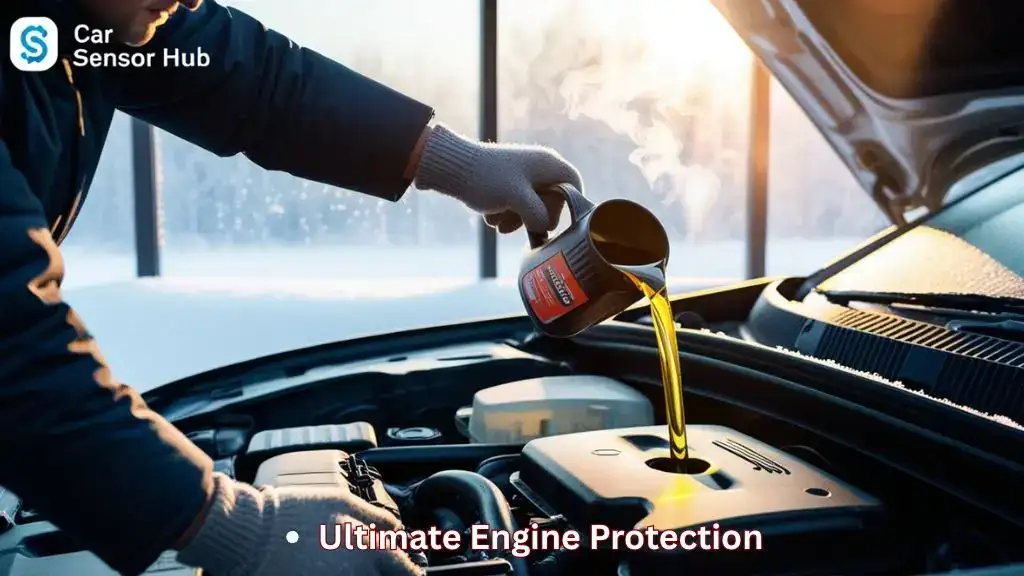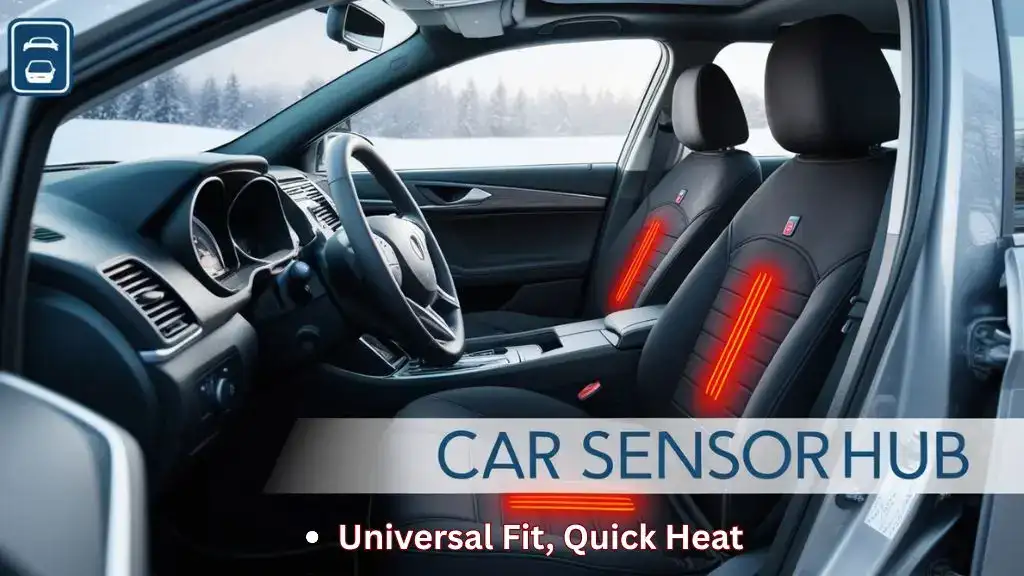Pick low-viscosity synthetic oil to protect engines and ensure fast, quiet winter starts.
I know how tough sub-freezing mornings feel on a car. You turn the key. The engine groans. Lights dim. That’s where the right Engine Oil for Cold Driving makes all the difference. Thin, high-quality synthetics flow fast, reduce wear, and keep fuel economy steady. I look for API SP and ILSAC GF-6 approvals (and GF-7 as it rolls into 2025 models) because these standards back real cold-start performance, timing chain protection, and turbo cleanliness. Below, I review top oils and treatments I trust for cold weather, from 0W-20 and 5W-30 for cars to small-engine formulas for snowblowers. I’ll help you match the best Engine Oil for Cold Driving to your vehicle and climate.
Valvoline Advanced Full Synthetic 0W-20, 5 QT
I pick this Valvoline 0W-20 when I want fast flow in deep cold and proven wear protection. Its low “0W” rating means it stays thin at sub-zero temps, so oil pumps quickly on start-up. That protects bearings and cam lobes when most wear happens. Valvoline’s full synthetic base stocks and robust detergent package help keep pistons, turbos, and timing chains clean over long intervals. It meets API SP and ILSAC GF-6A, which focus on low-speed pre-ignition control and chain wear—key for modern GDI and turbo engines often stressed by winter idling. For Engine Oil for Cold Driving, this blend hits the sweet spot of viscosity, fuel economy, and cold crank performance.
I like how it stabilizes fuel economy during long winter commutes. The 0W-20 grade reduces drag, and the friction modifiers stay active at low temperatures. I also value the resistance to oxidation, which helps when short trips don’t let engines fully warm up. In 2025, many OEMs recommend 0W-20 for cold climates, and this oil aligns well with those specs. I look for approvals and data like MRV (mini-rotary viscometer) limits and CCS (cold-cranking simulator) values under API SP, which show reliable cold pumping. If your owner’s manual calls for 0W-20, this Valvoline is one of my top Engine Oil for Cold Driving choices for reliable winter starts and quiet operation.
Pros
- Excellent cold-start flow for sub-freezing mornings
- API SP and ILSAC GF-6A approvals for modern engines
- Helps reduce timing chain wear in GDI/turbo motors
- Strong detergents keep engines clean over long intervals
- Supports steady winter fuel economy
Cons
- Not suitable if your vehicle requires 5W-30 or thicker
- Older engines with high mileage may prefer a higher viscosity
My Recommendation
I recommend this to drivers who want a trusted Engine Oil for Cold Driving in late-model cars that specify 0W-20. It’s great for cold starts, quiet running, and fuel savings. If you have a turbo or GDI engine, the API SP chain wear protection is a big plus. Availability is strong and value is excellent for a 5-quart jug.
| Best for | Why |
|---|---|
| Daily commuters in freezing climates | Fast cold flow reduces start-up wear |
| Modern GDI/turbo engines | API SP, LSPI and chain wear protection |
| Owners seeking fuel economy | Low-viscosity reduces friction in winter |
STP Premium Small Engine Oil 10W-30, 32 Oz
For snowblowers, push mowers, and small tractors that run in varying seasons, I like this STP 10W-30 small engine formula. Small engines work hard under load and benefit from an oil tuned for flat-tappet cams and splash lubrication. This Engine Oil for Cold Driving in small engines flows well enough for chilly starts while still giving a strong film at operating temperature. The additive system aims to reduce wear and deposits that can cause sticking rings or varnish, which is common when machines sit for months. The 32 oz size is practical for single oil changes, so I don’t leave half-open bottles in the garage.
In winter, keeping small engines reliable matters. I value oils that resist foaming, hold viscosity, and manage heat when a snowblower chews through heavy drifts. This STP formula is designed for 4-cycle small engines and supports cleaner operation and easier cold starts versus generic oils. Always follow the equipment manual, but for many air-cooled engines that call for 10W-30, this is a convenient Engine Oil for Cold Driving option. It helps reduce wear, stabilize performance, and extend the working life of seasonal equipment used in cold weather.
Pros
- Formulated for 4-cycle small engines
- Good balance of cold start flow and hot protection
- Additives target wear and deposit control
- Handy 32 oz size for one change
- Helps seasonal equipment start easier in cold
Cons
- Not intended for automotive engines
- 10W-30 may be thick for extreme Arctic temps
My Recommendation
I recommend this to homeowners who need reliable Engine Oil for Cold Driving in snowblowers and small tractors. It’s tuned for small-engine needs and reduces the chance of hard starts and wear. For deeper sub-zero climates, consider a 5W-30 small engine synthetic.
| Best for | Why |
|---|---|
| Snowblowers | Improves cold starts and reduces wear |
| Push mowers used in shoulder seasons | Balanced 10W-30 viscosity for variable temps |
| Small tractors | Sturdy film strength under load |
VP Racing 4-Cycle Oil SAE 30/10W-30, 18 Oz
VP Racing’s full synthetic small engine oil is built for performance and durability. The 10W-30 option offers better cold flow than straight SAE 30, which helps with Engine Oil for Cold Driving in compact equipment. Synthetic base stocks typically resist oxidation and thermal breakdown better than conventional oils, helpful for engines that see short, cold runs and long idle periods. The 18 oz bottle fits many small sump capacities, so it’s easy to pour with minimal leftover. I like the focus on wear reduction and deposit control, which keeps rings free and compression strong through winter workloads.
If I expect frequent cold starts, I favor the 10W-30 over straight SAE 30. It gets oil to bearings faster and can reduce start-up scuffing. For owners who run generators, pressure washers, or snow equipment in cold climates, this synthetic formula aligns with what I want from Engine Oil for Cold Driving: quick flow, stable viscosity, and clean operation. Always match the viscosity to your manual, but when allowed, a synthetic 10W-30 often delivers a smoother, easier start and a quieter engine note in cold air.
Pros
- Full synthetic base enhances cold flow and stability
- 10W-30 variant is better for cold starts than SAE 30
- Strong detergency keeps small engines clean
- Convenient 18 oz size for many sumps
- Good protection under heavy load
Cons
- SAE 30 straight grade is not ideal for very cold starts
- Premium price versus conventional oils
My Recommendation
I recommend the 10W-30 version to users who want small-engine Engine Oil for Cold Driving with synthetic protection. It’s ideal for generators and snow equipment that must start instantly when temps plunge. The performance-to-size value is solid if you prioritize protection.
| Best for | Why |
|---|---|
| Generators in winter | Reliable starts and steady load protection |
| Snow equipment | Faster oil flow reduces start-up wear |
| Performance-minded owners | Synthetic base fights oxidation and deposits |
Valvoline Advanced Full Synthetic 5W-30, 5 QT
When a vehicle spec calls for 5W-30, I like this Valvoline full synthetic for winter. It balances cold flow with a slightly thicker hot viscosity than 0W-20, which some engines prefer. As Engine Oil for Cold Driving, 5W-30 still cranks well below freezing while giving a confident film at operating temperature. It meets API SP and ILSAC GF-6A, addressing LSPI, chain wear, and deposit control—important for turbos and direct injection engines that face winter condensation and short trips.
In my experience, 5W-30 can quiet older engines or higher-mileage motors in the cold without hurting start-up. The advanced detergent and anti-wear package help keep internals clean, and the synthetic base resists oil thickening from oxidation. If your owner’s manual lists 5W-30 for all seasons, this is a reliable Engine Oil for Cold Driving that supports easy starts, smooth idle, and steady fuel economy. It’s a smart pick for mixed driving and moderate to severe cold.
Pros
- Strong cold-start performance for a 5W grade
- API SP/GF-6A standards for modern engines
- Good choice for higher-mileage vehicles
- Helps keep timing chains and turbos clean
- Wide availability and solid value
Cons
- Not as thin at start-up as 0W-20 in extreme cold
- Not suitable for cars requiring 0W-16/0W-20
My Recommendation
I recommend this to drivers whose manuals specify 5W-30 year-round. It’s a dependable Engine Oil for Cold Driving if you want a little extra hot viscosity while keeping easy winter starts. The price-to-performance ratio is excellent.
| Best for | Why |
|---|---|
| Older or higher-mileage engines | Thicker film at operating temp |
| Turbo/GDI vehicles | API SP addresses LSPI and chain wear |
| Mixed city/highway winter driving | Good balance of flow and protection |
Rislone XTREME LUBE Engine Treatment, 16.9 oz
This treatment is an additive, not a base oil. I use it when I want extra friction reduction and cleanliness on top of a good synthetic during winter. For Engine Oil for Cold Driving, an additive can help quiet lifter tick at cold start and improve boundary lubrication under high load. Formulas like this often include zinc/phosphorus anti-wear agents and friction modifiers. I add it within the recommended ratio and always confirm it is compatible with API SP oils and my vehicle’s warranty guidance.
I’ve seen smoother idle and slightly quieter valvetrain in cold conditions after using a reputable treatment. That said, additives are not a fix for mechanical issues, and a high-quality oil is the foundation. If you want to complement your winter oil with an extra layer of protection, this is a practical option. Use it as directed to support Engine Oil for Cold Driving, especially in older engines that could benefit from enhanced anti-wear chemistry.
Pros
- Can reduce friction and start-up noise
- Supports cleanliness and anti-wear protection
- Easy to dose into existing oil
- Helpful for older engines in winter
- May smooth idle in cold temps
Cons
- Not a substitute for correct oil viscosity
- Check warranty and compatibility before use
My Recommendation
I recommend this to owners of older or slightly noisy engines who want extra support for Engine Oil for Cold Driving. It’s best as a supplement to a high-quality API SP synthetic and correct viscosity. Use as directed for best results.
| Best for | Why |
|---|---|
| Older vehicles | Added anti-wear and friction reduction |
| Engines with slight lifter noise | May quiet cold-start tick |
| Harsh winter climates | Extra lubrication under boundary conditions |
Mobil 1 Advanced Fuel Economy 0W-16, 5 QT
For newer cars that specify 0W-16, Mobil 1 AFE is a standout. It’s very thin at start-up, which is excellent for Engine Oil for Cold Driving in extreme cold. It meets API SP and ILSAC GF-6B, the spec for lower-vis oils designed to boost fuel economy while protecting timing chains and turbos. I use 0W-16 only when the owner’s manual calls for it; modern engines designed for this grade have tight clearances and oil control hardware that match the viscosity.
In winter, 0W-16 can deliver lightning-fast oil pressure and minimal cranking resistance. I also appreciate Mobil 1’s oxidation resistance and deposit control, which help during short trips that create moisture and fuel dilution. For hybrids and late-model sedans optimized for efficiency, this is a reliable Engine Oil for Cold Driving that keeps starts quiet, revs light, and fuel use low. Always stick to the specified grade to protect your warranty and engine health.
Pros
- Exceptional cold-start performance
- API SP and ILSAC GF-6B approvals
- Supports maximum fuel economy
- Good timing chain wear protection
- Great for hybrids and late-model cars
Cons
- Use only if your manual specifies 0W-16
- Too thin for older engines not designed for it
My Recommendation
I recommend this to owners of vehicles that require 0W-16, especially hybrids and efficient sedans. It’s top-tier Engine Oil for Cold Driving if your car is built for ultra-low viscosity. The winter drivability gains are real.
| Best for | Why |
|---|---|
| Hybrids and newer sedans | Designed for 0W-16 efficiency |
| Extreme cold starts | Very low viscosity at low temps |
| Fuel-conscious drivers | Reduces friction to save fuel |
Briggs & Stratton Synthetic 5W-30, 32 Oz
For small engines in real winter, I favor a synthetic 5W-30 like this Briggs & Stratton formula. It’s engineered for air-cooled 4-cycle engines and provides excellent start-up flow in cold conditions while maintaining strong protection under heavy load. If you want Engine Oil for Cold Driving in snowblowers, this is one of the easiest ways to boost reliability. Synthetic oils resist oxidation from short, cold runs and help keep rings and valves cleaner during seasonal use.
I like this for owners who want a no-drama start on snow days. The 32 oz bottle is a perfect fill or top-off size for many machines. Follow your manual, but for most small engines that allow 5W-30, this delivers a smoother pull start or quick electric start in sub-freezing temps. As Engine Oil for Cold Driving, it strikes the right balance: fast flow, stable viscosity, and solid deposit control for long engine life.
Pros
- Excellent cold-start performance for small engines
- Synthetic base resists oxidation and varnish
- Great for snowblowers and winter equipment
- Convenient 32 oz packaging
- Strong protection under load
Cons
- Not intended for automotive engines
- Slightly higher cost than conventional small-engine oils
My Recommendation
I recommend this to anyone maintaining snow equipment who needs dependable Engine Oil for Cold Driving. It’s a go-to for easy starts and long service life in freezing weather.
| Best for | Why |
|---|---|
| Snowblowers | Fast flow at sub-freezing temps |
| Small generators | Stable viscosity during long runs |
| Seasonal equipment storage | Synthetic resists varnish and deposits |
FAQs Of Engine Oil for Cold Driving
What oil grade is best for cold starts?
Use the thinnest winter grade your manual allows. 0W-20 or 0W-30 often start easier than 5W-30 in deep cold.
Do I need synthetic oil for winter?
Synthetic flows faster in cold and resists oxidation. For reliable winter starts, I strongly prefer synthetic.
Is 0W-16 safe for my car?
Only if your manual specifies 0W-16. Many newer hybrids do. Otherwise, stick to the listed grade.
How often should I change oil in winter?
Follow the severe-service interval if you make short trips. Cold starts and idling can shorten oil life.
What certifications should I look for?
Look for API SP and ILSAC GF-6. New GF-7 is rolling into 2025 models for improved performance.
Final Verdict: Which Should You Buy?
For most cars, Valvoline Advanced Full Synthetic 0W-20 is my top Engine Oil for Cold Driving for fast starts, API SP protection, and value. If your manual calls for 5W-30, choose the Valvoline 5W-30. For 0W-16 vehicles and hybrids, pick Mobil 1 AFE 0W-16. For snow equipment, Briggs & Stratton Synthetic 5W-30 is the winter workhorse.
Disclosure: As an Amazon Associate, I may earn from qualifying purchases at no extra cost to you. Amazon and the Amazon logo are trademarks of Amazon.com, Inc, or its affiliates.
- Amazon, Amazon Prime, the Amazon logo and Amazon Prime logo are trademarks of Amazon. com, Inc. or its affiliates.

Hi, I am AKM Sad. I’m a car enthusiast and reviewer who loves exploring gadgets and accessories. I share honest reviews and practical tips to help you get the best products and enjoy a safer, smoother ride.










